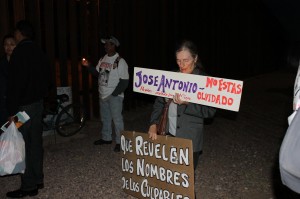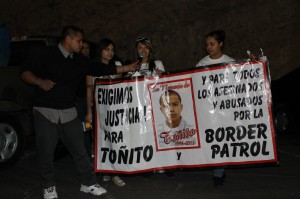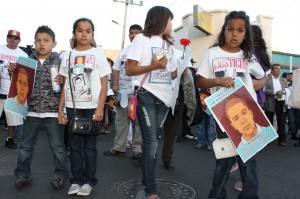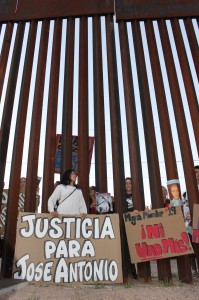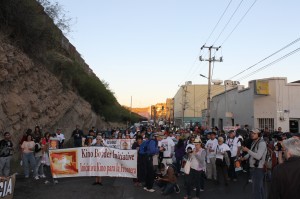NOGALES, SONORA, MEXICO – On Wednesday over a hundred supporters organized a vigil to commemorate Jose Antonio Elena Rodriguez on the 6th month marker of the day he was shot and killed by U.S. Border Patrol.
The boy was shot and killed by Border Patrol through the border fence into the Mexican side where he lived. The agents claimed that the boy was throwing rocks which locals have disputed to this day. Those who are familiar to the area say that it’s impossible to throw a rock from that location to even clear the wall, much less to endanger a Border Patrol agent on the other side. Our news crew investigated the area and found that conditions were such that it would be unlikely that a rock could even clear the border wall.
Participants to the vigil said that neither Border Patrol, the FBI nor the Department of Justice have been willing to release information about their findings or even if any investigation is taking place. Participants and family members have called for the names of the agents involved in the shooting and the release of the video taken by a border security camera. Derechos Humanos of Tucson is one group that is pressuring the U.S. Department of Justice to step in. Derechos Humanos says that according to policy, the involved Border Patrol agents are most likely working in the field to this day.
Eyewitness reports have emerged that José Antonio was simply walking down the street, and was not involved in rock-throwing against agents at the border wall. The autopsy report released by the Mexican government says that the boy was struck by at least eight bullets, mostly in the back after he was already on the ground.
The boy’s family took part in the vigil. Taide Elena is his grandmother and in a speech to the crowd, demanded answers from U.S. Border Patrol agents and the Mexican government, “The U.S. government doesn’t respond. The Mexican government either. What’s going on? Does the Mexican government not hear us? What is with the U.S. government who will not release the names of the persons who murdered my grandson? Why are they hiding them? Why are they defending them when they’ve committed a murder clearer than water? They murdered him in his Mexico. They obliterated him. ———-They shot him 13 times in his back. Why? Why do this without even knowing him? When he hadn’t even done anything. Why kill him? Why? This is a question that remains in the air. Because nobody can answer it. Nobody knows why. Only they. They must show their faces as if they are so valiant as to kill a child in his own country. As if they have a valid reason. Show your faces and defend your actions. —–Thank you for being here”.
People familiar with the area know of the likelihood that Jose Antonio was not involved in rock-throwing. Valeria is Jose Antonio’s cousin, “I [know] it’s not possible to throw a rock across that border and hit them [Border Patrol] and I think that’s no excuse for them to kill a teenager. I mean it’s impossible and all I want is for [there] to be justice”.
The lack of public information or accountability for the agents involved is similar to previous cases. Just in the past couple of years there have been 18 violent killings by Border Patrol/Customs and Border Protection. Ramsés Barrón Torres, 17, was another victim who on January 5, 2011, died in Nogales like José Antonio, on the Mexican side of the border wall. March 30 also marked the two-year anniversary of excessive force used against José Gutiérrez, who was violently beaten by Customs and Border Protection agents at the San Luis Port of Entry placing him in a coma for weeks. The statute of limitations has expired, and no charges were ever filed against the agents involved.
The excessive use of force that resulted in José Antonio’s, Ramsés’s and 16 other deaths seem not to be isolated incidents. The human rights group Derechos Humanos said that there is no accountability for Border Patrol violence. Many groups have said that given this dynamic, more violence is a likely consequence of the Border Patrol’s and the Obama administration’s militarized approach to border enforcement. In 2011 the human rights group No More Deaths published a report titled Culture of Cruelty that demonstrated results consistent with the position of Derechos Humanos. The report documented a 10% rate of physical abuse by Border Patrol agents against migrants in their custody.
This documentation of Border Patrol violence has been one key issue of concern to those in the immigrant rights movement. Some members of Congress, such as Cory Gardner of Colorado have expressed the move to increase what they say is “border security” but immigrant rights groups say that the practice will only lead to increased human rights violations.
Petra Paez/The Nation Report
